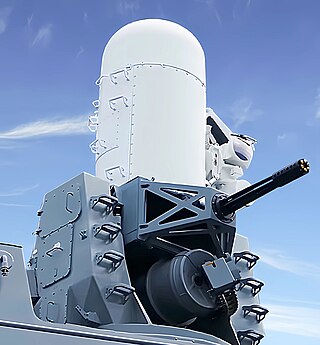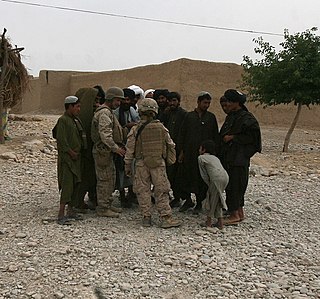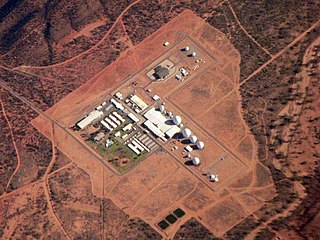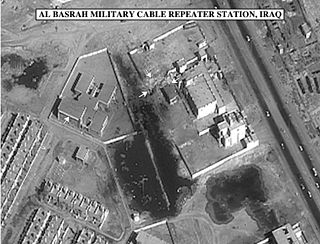Related Research Articles

The Phalanx CIWS is an automated gun-based close-in weapon system to defend military watercraft automatically against incoming threats such as aircraft, missiles, and small boats. It was designed and manufactured by the General Dynamics Corporation, Pomona Division, later a part of Raytheon. Consisting of a radar-guided 20 mm (0.8 in) Vulcan cannon mounted on a swiveling base, the Phalanx has been used by the United States Navy and the naval forces of 15 other countries. The U.S. Navy deploys it on every class of surface combat ship, except the Zumwalt-class destroyer and San Antonio-class amphibious transport dock. Other users include the British Royal Navy, the Royal Australian Navy, the Royal New Zealand Navy, the Royal Canadian Navy, and the U.S. Coast Guard.

Military intelligence is a military discipline that uses information collection and analysis approaches to provide guidance and direction to assist commanders in their decisions. This aim is achieved by providing an assessment of data from a range of sources, directed towards the commanders' mission requirements or responding to questions as part of operational or campaign planning. To provide an analysis, the commander's information requirements are first identified, which are then incorporated into intelligence collection, analysis, and dissemination.

Pine Gap is a joint United States-Australian satellite intelligence gathering and signals intelligence surveillance base and Australian Earth station approximately 18 km (11 mi) south-west of the town of Alice Springs. It is jointly operated by Australia and the United States, and since 1988 it has been officially called the Joint Defence Facility Pine Gap (JDFPG); previously, it was known as Joint Defence Space Research Facility. It plays a crucial role in supporting the intelligence activities and military operations of the US around the world. The base's role has caused much controversy in Australia leading to various protests.

The Goalkeeper CIWS is a Dutch close-in weapon system (CIWS) introduced in 1979. It is an autonomous and completely automatic weapon system for short-range defence of ships against highly maneuverable missiles, aircraft and fast-maneuvering surface vessels. Once activated the system automatically undertakes the entire air defence process from surveillance and detection to destruction, including the selection of the next priority target.

The Lockheed Martin Sniper is a targeting pod for military aircraft that provides positive target identification, autonomous tracking, GPS coordinate generation, and precise weapons guidance from extended standoff ranges.
Targeting is the process of selecting objects or installations to be attacked, taken, or destroyed in warfare. Targeting systematically analyzes and prioritizes targets and matches appropriate lethal and nonlethal actions to those targets to create specific desired effects that achieve the joint force commander's (JFC's) objectives, accounting for operational requirements, capabilities, and the results of previous assessments. The emphasis of targeting is on identifying resources (targets) the enemy can least afford to lose or that provide him with the greatest advantage, then further identifying the subset of those targets that must be acquired and engaged to achieve friendly success. Targeting links the desired effects to actions and tasks.
Qualified Weapons Instructor (QWI) (queue-why) is a qualification given to graduates of the British Armed Forces Qualified Weapons Instructor courses. It is the equivalent to the United States Air Force (USAF) Weapons School Course or United States Navy (USN) Naval Aviation Warfighting Development Center warfare schools.

Anti-surface warfare is the branch of naval warfare concerned with the suppression of surface combatants. More generally, it is any weapons, sensors, or operations intended to attack or limit the effectiveness of an adversary's surface ships. Before the adoption of the submarine and naval aviation, all naval warfare consisted of anti-surface warfare. The distinct concept of an anti-surface warfare capability emerged after World War II, and literature on the subject as a distinct discipline is inherently dominated by the dynamics of the Cold War.
Battlespace or battle-space is a term used to signify a military strategy which integrates multiple armed forces for the military theatre of operations, including air, information, land, sea, cyber and outer space to achieve military goals. It includes the environment, timeframe and other factors, and conditions that must be understood to successfully apply combat power, protect the force, or complete the mission. This includes enemy and friendly armed forces, infrastructure, weather, terrain, and the electromagnetic spectrum within the operational areas and areas of interest.

Target acquisition is the detection and identification of the location of a target in sufficient detail to permit the effective employment of lethal and non-lethal means. The term is used for a broad area of applications.

Bomb damage assessment (BDA), also known as battle damage assessment, is the practice of assessing damage inflicted on a target from a stand-off weapon, most typically a bomb or air launched missile. It is part of the larger discipline of combat assessment. Assessment is performed using many techniques including footage from in-weapon cameras, gun cameras, forces on the ground near the target, satellite imagery and follow-up visits to the target. Preventing information on battle damage reaching the enemy is a key objective of military censorship. For nuclear weapons special techniques may be required due to the extensive damage caused and difficulty in approaching the site.

Multiservice tactical brevity codes are codes used by various military forces. The codes' procedure words, a type of voice procedure, are designed to convey complex information with a few words.

On July 12, 2007, a series of air-to-ground attacks were conducted by a team of two U.S. AH-64 Apache helicopters in Al-Amin al-Thaniyah, New Baghdad, during the Iraqi insurgency which followed the invasion of Iraq. On April 5, 2010, the attacks received worldwide coverage and controversy following the release of 39 minutes of classified gunsight footage by WikiLeaks. The video, which WikiLeaks titled Collateral Murder, showed the crew firing on a group of people and killing several of them, including two Reuters journalists, and then laughing at some of the casualties, all of whom were civilians. An anonymous U.S. military official confirmed the authenticity of the footage, which provoked global discussion on the legality and morality of the attacks.
A no-drive zone is a form of interdiction and specifically a militarily enforced declaration of an intent to deny vehicular movement over a strategic or tactically valued line of communication by the threat of vehicle destruction. A capability first used in the Balkans and a term recently coined during the 2011 Libyan civil war as a potential course of action to prevent Muammar Gaddafi's government forces from approaching rebel strongholds near Benghazi, no-drive zones present unique challenges to military planners and warfighters. Unlike no-fly zone enforcement where electronic and visual means of identification of relatively few air entities allow warfighters to sort out potential targets, no-drive zones may include a variety of vehicle types with no electronic signatures to identify themselves and where enemy, friendly, and unaffiliated traffic are co-mingled. Enforcement from the air is further complicated by the necessary coordination with ground controller units providing persistent surveillance and possible identification when airborne intelligence, surveillance and reconnaissance (ISR) assets are unavailable or denied necessary airspace access.

Counter-IED efforts are done primarily by military and law enforcement with the assistance of the diplomatic and financial communities. It involves a comprehensive approach of countering the threat networks that employ improvised explosive devices (IEDs), defeating the devices themselves, and training others. Counter-IED, or C-IED, is usually part of a broader counter-terrorism, counter-insurgency, or law enforcement effort. Because IEDs are a subset of a number of forms of asymmetric warfare used by insurgents and terrorists, C-IED activities are principally against adversaries and not only against IEDs. C-IED treats the IED as a systemic problem and aims to defeat the IED threat networks themselves.
Tactics, Techniques, and Procedures (TTPs) is an essential concept in terrorism and cyber security studies. The role of TTPs in terrorism analysis is to identify individual patterns of behavior of a particular terrorist activity, or a particular terrorist organisation, and to examine and categorize more general tactics and weapons used by a particular terrorist activity, or a particular terrorist organisation.

The Raytheon Coyote is a small, expendable, unmanned aircraft system built by the Raytheon Company, with the capability of operating in autonomous swarms. It is launched from a sonobuoy canister with the wings deploying in early flight phase.
A military artificial intelligence arms race is an arms race between two or more states to develop and deploy lethal autonomous weapons systems (LAWS). Since the mid-2010s, many analysts have noted the emergence of such an arms race between global superpowers for better military AI, driven by increasing geopolitical and military tensions.

The cyber kill chain is the process by which perpetrators carry out cyberattacks. Lockheed Martin adapted the concept of the kill chain from a military setting to information security, using it as a method for modeling intrusions on a computer network. The cyber kill chain model has seen some adoption in the information security community. However, acceptance is not universal, with critics pointing to what they believe are fundamental flaws in the model.
As part of the Israel–Hamas war, the Israel Defense Force (IDF) has used artificial intelligence to rapidly and automatically perform much of the process of determining what to bomb. Israel has greatly expanded the bombing of the Gaza Strip, which in previous wars had been limited by the Israeli Air Force running out of targets.
References
- ↑ "Kill Chain Approach". Chief of Naval Operations. April 23, 2013. Archived from the original on June 13, 2013.
- ↑ Jonathan Greenert; Mark Welsh (May 17, 2013). "Breaking the Kill Chain". Foreign Policy. Archived from the original on December 9, 2022. Retrieved June 30, 2016.
- ↑ "Lockheed-Martin Corporation-Hutchins, Cloppert, and Amin-Intelligence-Driven Computer Network Defense Informed by Analysis of Adversary Campaigns and Intrusion Kill Chains-2011" (PDF). Archived (PDF) from the original on 2021-07-27. Retrieved 2021-08-26.
- ↑ John A. Tirpak (July 1, 2000). "Find, Fix, Track, Target, Engage, Assess". Air Force Magazine.
- ↑ Benitez, Mike (May 17, 2017). "It's About Time: The Pressing Need to Evolve the Kill Chain". War on the Rocks. Archived from the original on June 8, 2020. Retrieved April 28, 2020.
- ↑ "The OODA Loop: How Fighter Pilots Make Fast and Accurate Decisions". fs.blog. March 15, 2021. Archived from the original on September 27, 2023. Retrieved September 10, 2023.
- ↑ Sanger, David E. (July 6, 2017). "Tiny Satellites From Silicon Valley May Help Track North Korea Missiles". The New York Times. Archived from the original on July 7, 2017. Retrieved July 7, 2017.
- ↑ "06/30/17 - Joint Statement between the United States and the Republic of Korea | U.S. Embassy & Consulate in Korea". U.S. Embassy & Consulate in Korea. 2017-06-30. Retrieved 2017-07-07.[ permanent dead link ]